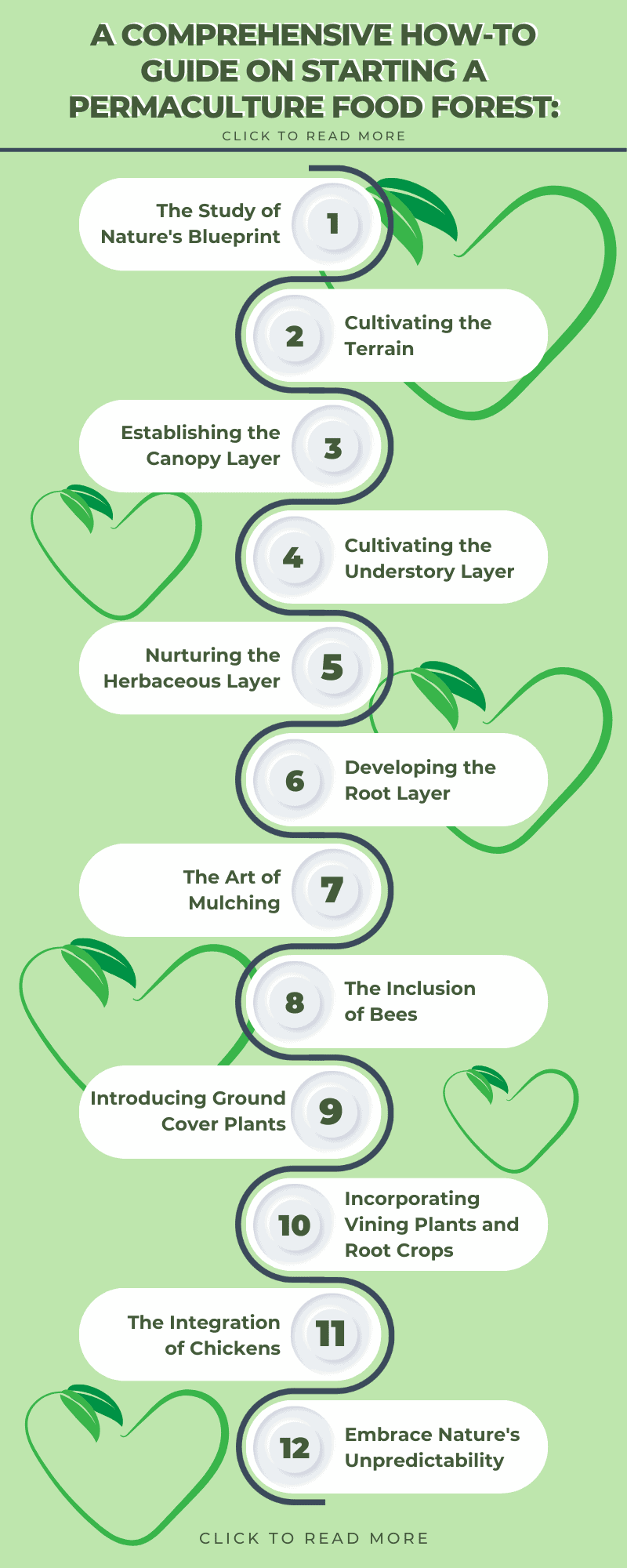In the heart of nature, we discover a fascinating and ingenious system - the permaculture food forest. A low-maintenance and sustainable method of growing food, it mirrors the natural structure of forests, creating a self-sustaining environment teeming with diverse flora and fauna.
The Permaculture Food Forest: A Journey into Sustainable Agriculture

Step 1: The Study of Nature's Blueprint
Embarking on this journey begins with research and planning. Contemplate the dimensions and location of your food forest, the plants and creatures inhabiting it, and its long-term management.
Crucial factors include local climate, soil composition, and water accessibility. Furthermore, sunlight exposure will determine the assortment of plants that can flourish.
Step 2: Cultivating the Terrain
With a plan in motion, initiate the clearing and preparation of the area. This may entail the removal of plants, weeds, and debris.
Enhancing soil fertility may require the addition of compost or other organic matter. A soil test to ascertain nutrient levels and pH is advisable, adjusting as necessary.
From Canopy to Root Layer: Building a Thriving Permaculture Food Forest
Step 3: Establishing the Canopy Layer
The canopy layer, composed of towering trees, offers shade and structure to the food forest. Opt for trees that thrive in your specific climate and soil, providing food, shade, or other ecological advantages.
Fruit trees, nut trees, and nitrogen-fixing varieties like alder or black locust are suitable selections. Plant these first, as their establishment will surpass that of other plants.
Step 4: Cultivating the Understory Layer
The understory layer comprises smaller trees, shrubs, and bushes, flourishing beneath the canopy layer. These plants should complement the canopy, providing additional sustenance or habitat for fauna.
Blueberries, raspberries, currants, and other berry bushes are excellent choices. Hazelnuts, elderberries, and other edible shrubs may also be considered.
Step 5: Nurturing the Herbaceous Layer
The herbaceous layer consists of ground-level plants like herbs, flowers, and groundcovers, offering food, medicine, or other ecosystem benefits.
Mint, thyme, oregano, and edible flowers like calendula or nasturtium are prime examples. Clover or violets may serve as groundcovers.
Permaculture Food Forests: The Low-Maintenance, Self-Sustaining Way to Grow Food
Step 6: Developing the Root Layer
The root layer is comprised of plants with deep root systems that bolster soil health and prevent erosion. These plants may also furnish food or other ecosystem benefits.
Carrots, beets, and other root vegetables are fitting choices. Comfrey, with its deep taproots, can help break up compacted soil.
Step 7: The Art of Mulching
Once all layers are planted, mulching is essential to retain moisture, suppress weeds, and enhance soil health.
Organic materials like wood chips, straw, or leaves are recommended for mulching. Synthetic materials, such as plastic or rubber, should be avoided as they can harm the ecosystem.
Step 8: The Inclusion of Bees
Bees, vital pollinators, can augment the productivity of your food forest.
Honeybees, bumblebees, and mason bees are excellent for pollination and can be attracted with flowering plants, nesting boxes, and water sources. Consider the location and potential hazards, like pesticide use, to ensure bee safety and ecosystem impact.
Step 9: Introducing Ground Cover Plants
These smaller, shade-tolerant plants can be sown after the danger of frost has passed. Alpine strawberries, lettuces, nasturtiums, and beans are fitting options.
Step 10: Incorporating Vining Plants and Root Crops
Mostly annuals, these plants should be added last and replanted yearly. Plant them once frost danger has subsided. Examples include:
Potatoes, sweet potatoes, squash, pumpkin, cucumber, and grapes. These plants can be trained to grow up established trees and shrubs, provided they do not interfere with the host plant's growth. While this may result in a less orderly garden, it will prove effective.
Alternatively, simple trellises or fences can be added to your food forest for these plants to climb. If space permits, they can also sprawl across the ground.
Discover the Beauty and Functionality of Permaculture Food Forests
Step 11: The Integration of Chickens
Chickens make a splendid addition to any food forest, offering fresh eggs, meat, fertilizer, and pest control assistance.
If you choose to keep chickens, fence them in to prevent damage to developing plants. Allow them to free-range in the fall and winter after harvesting is complete. They can consume leftover produce and turn over any bare ground.
Chickens will also consume pests that might threaten your vegetables, providing natural pest control without harming beneficial insects or diminishing your crop yield.
Step 12: Embrace Nature's Unpredictability
Expect the unexpected, as some plants may not thrive as anticipated, while others may exceed expectations.
Learn from experience, replacing unsuccessful plants with new varieties. Monitor the health of your food forest as it establishes itself. Once established, it should require minimal maintenance. However, irrigation during droughts and occasional pruning may be necessary to promote growth.
Over time, experiment with additional plants and techniques in your food forest.
As you delve into the adventure of designing and cultivating your food forest, you may encounter questions about costs, land requirements, and more. Trust in the wisdom of nature, learn from its intricate systems, and allow the permaculture food forest to guide you towards sustainable agriculture.
Embed this infographic on your site.

